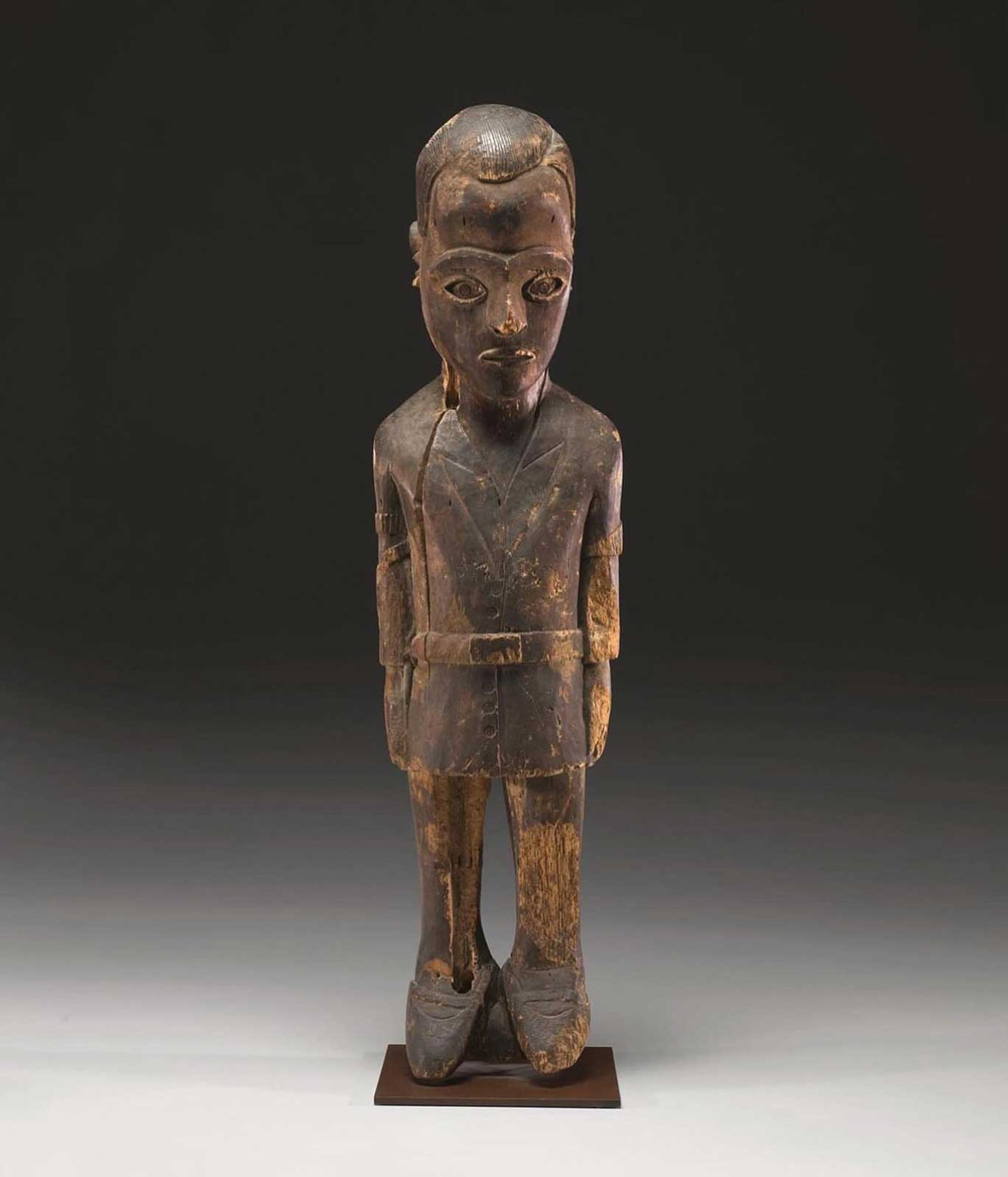A much-anticipated work from the 2024 Venice Biennale will be unveiled on video screens, while the object itself will return to its country of origin, albeit on temporary loan from the American institution that has owned it since 2015.
The sculpture is a wooden portrait of a white colonial ruler in the 1930s, made in the Belgian Congo in revenge for a local rebellion that resulted in the official’s death. The Virginia Museum of Fine Arts (VMFA) in the United States has allowed the Dutch pavilion of the Biennale to broadcast images of the sculpture, following an initiative by a Congolese artist cooperative to sell NFTs (non-fungible tokens) of the sculpture. The object itself will be loaned to the White Cube Museum in Lusanga, Democratic Republic of the Congo.
work is Statue of a chief or diviner representing the Belgian colonial official Maximilien Barlot (circa 1931), a two-foot-tall wooden sculpture of officials investigating the rape of a Pende woman in the Kwelu region of central Congo. At that time Lusanga was named Leverville by British palm oil tycoon William Lever. (Lever Brothers later became Unilever.)
The rape was committed by a Belgian palm nut cutter recruiter. The statue was built to focus the resentment of the Pende people against Maximilian Balot, who was killed during a conflict while investigating rape accusations and collecting taxes. Balot’s murderers beheaded him, split his body in half, and divided his remains among the Pende people. The clothes and appearance carved on the sad-looking statue are those of colonial officials. Experts say the Pende rebellion lasted four months and saw more than 1,300 Africans killed in revenge for Balot.
The Balot sculpture was sold in Belgium in 1972 for $700 to Herbert F. Weiss, a collector and political science professor from New York who specialized in the Congo. Weiss sold to VMFA in 2015 for $24,000. A spokesman for the museum stressed that the work was obtained legally, although the Lusanga-based artists called their Balot NFT strategy “digital restitution.”
In 2017, the Art Alliance of Congolese Plantation Workers (CATPC) approached the VMFA to loan the work to the new White Cube Museum on the site of the former Lever Plantation.The building is designed to free of charge Designed by the Office for Metropolitan Architecture (OMA), founded by Dutch architect Rem Koolhaas. VMFA denied the loan request.
CATPC plans to monetize contemporary sculptures cast in chocolate by its members to purchase land for reforestation. In 2022, CATPC released an NFT replica of Barot’s sculpture with the help of Dutch artist Renzo Martens, whose film traces the regeneration project over nearly 20 years, and Berlin-based KOW gallery, which represents the artist collective. KOW’s publicist, who is still selling Martens, said that NFT is a non-fungible token.
“For every purchase of one of 306 NFTs, you can purchase and receive two and a half acres of depleted plantation land,” CATPC members announced at the time. “Each purchase helps further unlock the power of the sculpture and re-realize its original purpose. Function: Protect our lands and people.”
The VMFA called the release of the NFT “unethical and unprofessional” but agreed in February to loan the item and promote its presence in Venice by streaming the video. The Dutch pavilion exhibition, designed by Martens and funded by the Mondrian Foundation (which also funded the transport of Balot’s sculptures to Lusanga), will also feature sculptures made by CATPC members.
Weiss, 93, who lives in Washington, D.C. The Art Newspaper About the Barlot sculpture and its acquisition. In 1931, Balot’s body was chopped into pieces after he was killed, and parts of the body were distributed to the Pende chiefs, as it was believed that preserving the remains, like sculptures, would ward off his influence. Only about a third of these remains have been found.
“There are no other similar objects”
In 1972, in the town of Gungu, a local man raised money for children’s school fees and provided Weiss with two sculptures – one by Balot and the other for $120 each. One is the female Pende statue. Weiss bought the female statue, but lacking the cash to purchase two statues, he asked the seller about the Balot statue and its origins. Later that year, Weiss mentioned the Belgian Balot figure. Later, the Balot sculpture was discovered in Gongu and brought back to Belgium, where Weiss bought it for $700.
There’s an eerie stiffness to the dark wood’s depiction of sullen white men. This is not an object made to bring happiness to people.Sculptor unknown, but a thorough article african art Beginning in 2016, Weiss and two other experts noted that special modifications were made to give the sculpture power.

Statue of a chief or diviner representing the Belgian colonial official Maximilien Barlotby an unknown artist, created around 1931
Virginia Museum of Fine Arts, Aldine S. Hartmann Endowment Fund, 2015.3.Photo: Travis Fullerton © Art Gallery of Virginia
“As far as I know, this is unique,” Weiss said The Art Newspaper. “As far as I know, there are no other similar objects.”
Weiss said Martens and company have “opened Pandora’s box” in the craze since NFT replicas hit the market. While there are calls for return, “Who do you return it to?” Weiss asked. He said the CATPC artist “is not Pende. Lusanga is not Pende”.
“Unilever has been out of there for many years, decades, so the business of buying back land from plantations – there are no plantations,” he said. “There certainly are no plantations in Europe, so it’s a Gimme, but anything that can bring some wealth, some support to rural Africa, I’m 100 percent for it.

